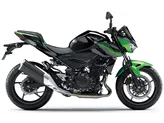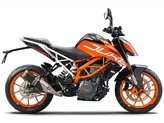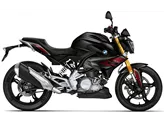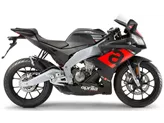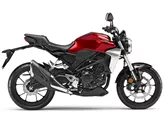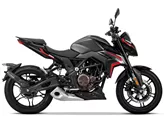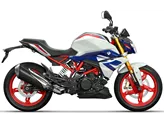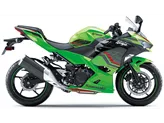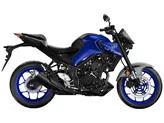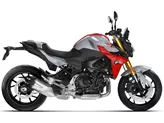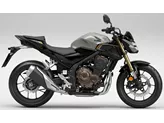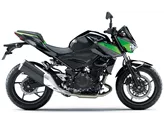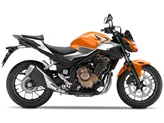BMW G 310 R 2016 vs. Kawasaki Z 400 2019

BMW G 310 R 2016

Kawasaki Z 400 2019
Pregled - BMW G 310 R 2016 vs Kawasaki Z 400 2019
The BMW G 310 R 2016 and the Kawasaki Z 400 2019 are both naked bikes in the same category, but they have some notable differences in terms of technical specifications and strengths.
Starting with the engine and drive train, the BMW G 310 R 2016 is equipped with a single-cylinder engine that produces 34 horsepower and 28 Nm of torque. On the other hand, the Kawasaki Z 400 2019 features a twin-cylinder engine with a higher power output of 45 horsepower and 38 Nm of torque. This means that the Kawasaki Z 400 has more power and torque, offering a more exhilarating riding experience.
Both bikes have fuel injection systems and liquid cooling, ensuring optimal performance and efficiency. The BMW G 310 R has a displacement of 313 cc, while the Kawasaki Z 400 has a slightly larger displacement of 399 cc.

BMW G 310 R 2016
In terms of suspension, both bikes have a swing arm rear suspension with a monoshock. However, the BMW G 310 R 2016 has an upside-down telescopic fork front suspension, while the Kawasaki Z 400 2019 has a conventional telescopic fork front suspension. This difference in front suspension design may result in variations in handling and comfort.
Both bikes have steel frames with tubular construction, providing a sturdy and reliable chassis. They also feature single disc brakes on the front, with the BMW G 310 R having a 300 mm diameter and the Kawasaki Z 400 having a slightly larger 310 mm diameter. Both bikes are equipped with ABS, ensuring enhanced safety and control.
In terms of dimensions and weights, the BMW G 310 R has a front tire width of 110 mm and a rear tire width of 150 mm, with both bikes having 17-inch diameter tires. They also have similar wheelbases of around 1370-1374 mm and seat heights of 785 mm. However, the Kawasaki Z 400 2019 has a larger fuel tank capacity of 14 liters compared to the BMW G 310 R's 11 liters.
Now, let's move on to the strengths and weaknesses of each bike. The BMW G 310 R 2016 is praised for its exceptional handling, thanks to its ingenious chassis design. It is also relatively lightweight at 158.5 kg, which contributes to its agility and maneuverability. Additionally, the BMW G 310 R offers good stability on the road.

Kawasaki Z 400 2019
On the other hand, the Kawasaki Z 400 2019 is known for its great and very controllable power delivery. It has a low weight of 167 kg, making it easy to handle and maneuver. The bike also offers a good seating position, ensuring rider comfort. Furthermore, the Kawasaki Z 400 has a great sound, adding to the overall riding experience. It is also considered suitable for novice riders due to its manageable power.
In terms of weaknesses, the BMW G 310 R 2016 is criticized for its brake pedal, although specific details are not provided. On the other hand, the Kawasaki Z 400 2019 has non-adjustable clutch and brake levers, which may limit customization options for some riders. Additionally, the Kawasaki Z 400 has a limited adjustable chassis, potentially limiting the fine-tuning of the bike's handling characteristics.
In conclusion, the BMW G 310 R 2016 and the Kawasaki Z 400 2019 are both capable naked bikes with their own strengths and weaknesses. The BMW G 310 R offers excellent handling, a lightweight design, and a stable ride. On the other hand, the Kawasaki Z 400 provides great power delivery, a low weight, a comfortable seating position, and is suitable for novice riders. Ultimately, the choice between the two will depend on individual preferences and priorities.
Tehnične specifikacije BMW G 310 R 2016 v primerjavi z Kawasaki Z 400 2019
Primerjava prednosti in slabosti
Primerjava prednosti in slabosti
BMW G 310 R 2016

Na prvih nekaj metrih se mi je za kratek čas zdelo, da je moč nekoliko premajhna. Vendar je po nekaj časa hitro postalo jasno, da moč ni vse in da je vrhunski užitek v vožnji zagotovljen tudi z malo konjskimi močmi. V ZDA obstajajo prometna pravila, imenovana "lane splitting", ki pomenijo premikanje naprej med avtomobili, kadar je zastoj. Pred semaforjem, na primer. Priznati moram, da se tu na začetku nisem počutil tako udobno. Porsche na levi, Dodge na desni, s kolesom res ne želite zavijati. Vendar je krmilo BMW G310R precej ozko in res si lahko brez pomislekov utiraš pot naprej skozi kolone avtomobilov! Edina pomanjkljivost, ki sem jo opazil takoj na začetku, je zavorni pedal. Na žalost je nekoliko oddaljena. Tudi zadnja zavora se je vklapljala nekoliko pozno. Vendar se to vsekakor lahko optimizira z nastavitvijo. Na splošno je to zelo uspešno kolo. Je izjemno vsestransko, res zabavno na vseh področjih in že od prvega trenutka se počutite udobno! Glede na območje vrtljajev, v katerem se nahajate, lahko kolo prilagodite svojemu slogu vožnje. Križarjenje pri nizkih vrtljajih in izjemno športna vožnja pri visokih vrtljajih! Popoln vsestranski roadster po odlični ceni.
Kawasaki Z 400 2019

Kawasaki Z400 je vsekakor odlična nadgradnja predhodnika Z300. Več moči, manjša teža - preprosto še boljše kolo. Predvsem zaradi linearnega podajanja moči in odličnega upravljanja je Z400 idealno vstopno kolo. V tem duhu sta tudi enostavno upravljanje sklopke in dobra nastavitev podvozja, zato lahko Z400 brez oklevanja priporočimo voznikom začetnikom.
Primerjava povprečnih tržnih cen BMW G 310 R vs Kawasaki Z 400
There are a few key differences between a BMW G 310 R 2016 and a Kawasaki Z 400 2019. Since model year 2016 1000PS.de editors have written 16 reviews for the BMW G 310 R and 8 reviews for the Kawasaki Z 400 since model year 2019. The first review for the BMW G 310 R was published on 10/7/2015 and now has more than 28,500 views. This compares to more than 23,200 views for the first review on Kawasaki Z 400 published on 10/2/2018.


